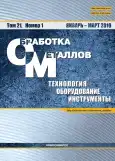Analysis and Synthesis of Vibration Isolation System of a Grinding Machine with Account of the Operational Reliability of its Elements
- Authors: Bratan S.M.1, Kharchenko A.O.1, Vladetskaya Y.A.1, Kharchenko A.A.1
-
Affiliations:
- Issue: Vol 21, No 1 (2019)
- Pages: 35-49
- Section: TECHNOLOGY
- URL: https://bakhtiniada.ru/1994-6309/article/view/302017
- DOI: https://doi.org/10.17212/1994-6309-2019-21.1-35-49
- ID: 302017
Cite item
Full Text
Abstract
About the authors
S. M. Bratan
Email: serg.bratan@gmail.com
D.Sc. (Engineering), Professor, Sevastopol State University, 33 Universitetskaya str., Sevastopol, 299053, Russian Federation, serg.bratan@gmail.com
A. O. Kharchenko
Email: khao@list.ru
Ph.D. (Engineering), Professor, Sevastopol State University, 33 Universitetskaya str., Sevastopol, 299053, Russian Federation, khao@list.ru
Y. A. Vladetskaya
Email: vladetska@rambler.ru
Ph.D. (Engineering), Sevastopol State University, 33 Universitetskaya str., Sevastopol, 299053, Russian Federation, vladetska@rambler.ru
A. A. Kharchenko
Email: a.a.kharchenko@sevsu.ru
Ph.D. (Engineering), Associate Professor, Sevastopol State University, 33 Universitetskaya str., Sevastopol, 299053, Russian Federation, a.a.kharchenko@sevsu.ru
References
- Siddique A.N., Khan Z.A, Mallick Z. Grey relational analysis coupled with principal component analysis for optimization design of the process parameters in in-feed centerless cylindrical grinding. // International Journal of Advanced Manufacturing Technology. – 2010. – Vol. 46, iss. 9–12. – P. 983–992. – doi: 10.1007/s00170-009-2159-8.
- Li G.F., Wang L.S., Yang L.B. Multi parameter optimization and control of the cylindrical grinding process // Journal of Material Processing Technology. – 2002. – Vol. 129, iss. 1. – P. 232–236. – doi: S0924-0136(02)00607-6.
- Kumar S., Dhanabalan S. A review of cylindrical grinding process parameters by using various optimization techniques and their effects on the surface integrity, wear rate and MRR // International Journal of Advance Engineering and Research Development (IJAERD). – 2018. – Vol. 5, iss. 01. – P. 719–729. – doi: 10.13140/RG.2.2.30801.43368.
- Kumar S., Bhatia O. Review of analysis and optimization of cylindrical grinding process parameters on material removal rate of En15AM steel // IOSR Journal of Mechanical and Civil Engineering. – 2015. – Vol. 12, iss. 4, ver. 2. – P. 35–43.
- Subsurface damage in high-speed grinding of brittle materials considering kinematic characteristics of the grinding process / C. Wang, Q. Fang, J. Chen, Y. Liu, T. Jin // The International Journal of Advanced Manufacturing Technology. – 2016. – Vol. 83, iss. 5–8. – P. 937–948. – doi: 10.1007/s00170-015-7627-8.
- Kumar P., Kumar S., Kumar Dev D. Grinding processes, a review // International Journal of Engineering Technology, Management and Applied Sciences. – 2016. – Vol. 4, iss. 9. – P. 68–72.
- Kumar P., Kumar A., Singh B. Optimization of process parameters in surface grinding using response surface methodology // International Journal of Research in Mechanical Engineering & Technology (IJRMET). – 2013. – Vol. 3, iss. 2. – P. 245–252.
- Vinay P.V., Rao C.S. Grinding mechanics and advances – a review // International Journal of Advance Engineering and Research Development (IJAERD). – 2013. – Vol. 5, no. 2. – P. 41–74.
- Srinivasan K. Grinding chatter and vibrations // King R.I., Hahn R.S. Handbook of modern grinding technology. – New York; London: Chapman and Hall, 1986. – P. 119–169.
- Kumar S., Bhatia O.S. Experimental analysis and optimization of cylindrical grinding process parameters on surface roughness of En15AM steel // International Journal of Engineering Research and Applications. – 2015. – Vol. 5, iss. 7, pt. 2. – P. 01–08.
- Optimization of grinding parameters for minimum surface roughness by Taguchi parametric optimization technique / D. Pal, A. Bangar, R. Sharma, A. Yadav // International Journal of Mechanical and Industrial Engineering (IJMIE). – 2012. – Vol. 1, iss. 3. – P. 74–78.
- Лобанов Д.В., Мулюхин Н.В. Методика прогнозирования поврежденности твердого сплава при затачивании инструмента для обработки неметаллических композитов // Актуальные проблемы в машиностроении. – 2018. – Т. 5, № 1–2. – С. 78–84.
- Солер Я.И., Хоанг Н.А. Влияние глубины резания на высотные шероховатости инструментов из стали У10А при плоском шлифовании кругами из кубического нитрида бора // Авиамашиностроение и транспорт Сибири: сборник статей IX Всероссийской научно-практической конференции / Иркутский национальный исследовательский технический университет. – Иркутск, 2017. – С. 250–254.
- Soler Y.I., Van Le N., Dinh Si M. Influence of rigidity of the hardened parts on forming the shape accuracy during flat grinding // MATEC Web of Conferences. – 2017. – Vol. 129. – P 01076. – doi: 10.1051/matecconf/201712901076.
- Солер Я.И., Нгуен В.К., Хоанг Н.А. Прогнозирование режимов чистового шлифования быстрорежущих пластин переменной податливости при многопараметрической оптимизации шероховатости // Известия высших учебных заведений. Машиностроение. – 2017. – № 4 (685). – С. 35–46.
- Fomin A.A., Gusev V.G. Vibrational displacement of a spindle with static disequilibrium of the cutting tool // Russian Engineering Research. – 2013. – Vol. 33, N 7. – P. 412–415. – doi: 10.3103/S1068798X1307006X.
- Фролов К.В., Фурман Ф.А. Прикладная теория виброзащитных систем. – М.: Машиностроение, 1980. – 276 с.
- Владецкая Е.А. Моделирование вибрационных воздействий от внешних источников при шлифовании деталей в лабораторных условиях / Е.А. Владецкая // Вестник современных технологий. – 2016. – Вып. 4. – С. 25–34.
- Повышение качества деталей при шлифовании в условиях плавучих мастерских / С.М. Братан, Е.А. Владецкая, Д.О. Владецкий, А.О. Харченко. – М.: Вузовский учебник: Инфра-М, 2018. – 154 с. – ISBN 978-5-9558-0598-6.
- Патент 158629 Российская Федерация, МПК B 23 Q 1/25, B 23 Q 1/44, F 16 F 9/14. Устройство автоматической виброзащиты металлорежущего станка / Е.А. Владецкая, А.О. Харченко, С.М. Братан. – № 2015125213/02; заявл. 25.06.2015, опубл. 20.01.2016, Бюл. № 2. – 5 с.
Supplementary files






